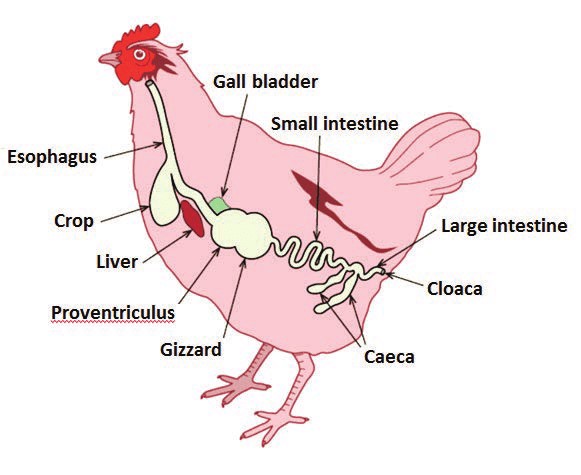
Eating Like a Bird
Birds eat a wide variety of foods such as seeds, nuts, fruits, grasses, flowers, insects, rodents, fish, amphibians, the list goes on. With such a wide variety in their diet, you can imagine the variations in how different birds break down and digest their food.
Digestion in birds is faster and more efficient than in other vertebrate groups, involving many different organs, each performing a specific function.
Let’s start with the crop, an expandable pouch that is an extension of the bird’s esophagus. Birds are opportunistic and will take advantage of a food source when it is available. Sometimes, that means eating more than they can digest, or eating very quickly to escape a predator. For many birds, the surplus or undigested food is stored in their crop to digest at another time.
The food then passes into the proventriculus, sometimes referred to as the ‘true stomach’, where digestion enzymes are secreted and mixed with food before it passes into the gizzard.
Since birds have no teeth, most of the crushing and disassembling of food happens in the remarkably strong and muscular gizzard. (Evolutionarily speaking, swapping teeth for a gizzard not only helped to reduce weight, but also moved the center of gravity under their wings, a more aerodynamic distribution of weight!) Many birds will swallow small rocks to provide a hard grinding surface that helps pulverize food in the gizzard. This allows birds such as surf scoters that dive for crustaceans and mollusks to crush, disassemble, and digest the hard shells. Little stones in the gizzard also help birds that mostly eat plant material such as geese, as cellulose is difficult to break down with stomach acids alone.
Another fascinating variation in the realm of bird digestion is found in grebes. These water birds that feast on fish swallow their own feathers as they preen which accumulate in the region between the gizzard and the intestine. The clump of feathers serves as a filter for sharp fish bones, blocking them from moving into the intestine. The bones and feathers are periodically regurgitated in the form of pellets, similar to owls.
The extended necks, blade-like bills, and long legs built for wading make great blue herons excellent hunters. Capable of foraging fish at lightning fast speeds, but lacking the tools for tearing apart their prey, they must swallow the fish whole. Always swallowing the fish headfirst so the spiny tail and rough body scales slide down their throat “smoothly.” The herons throat bulges as the fish slides down, and sometimes the heron’s eyes are bigger than its stomach and the prey can cause the bird to choke.
Lacking a major crop or a gizzard, the herons meals move down their extremely flexible esophagus and into their loose and stretchable stomach where very acidic secretions soften the bones by the time they are exposed, eventually providing an excellent source of calcium for the birds.
The idiom “eat like a bird” alludes to the idea that birds eat very little. Anyone who studies, observes, or feed birds, know this notion is a misconception. Birds eat more than horses relative to their body weight! So whether you eat like a bird, or eat like a horse, we wish you a bountiful, safe and healthy holiday!
Happy Thanksgiving from the Dungeness River Nature Center!


